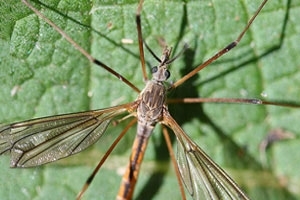Cranefly
 The cranefly, more commonly known as the daddy long-legs, reaches peak numbers during the month of September and will no doubt prove this by crashing around your house, if you leave a combination of lights on and windows open, this month. Many people absolutely hate the random way they fly around, bashing into objects and dropping down on to unsuspecting individuals. In fact, they were voted the second scariest creature after the spider! There are plenty of them to be frightened of as well, with around 300 different species of cranefly in this country and some 14,000 worldwide.
The cranefly, more commonly known as the daddy long-legs, reaches peak numbers during the month of September and will no doubt prove this by crashing around your house, if you leave a combination of lights on and windows open, this month. Many people absolutely hate the random way they fly around, bashing into objects and dropping down on to unsuspecting individuals. In fact, they were voted the second scariest creature after the spider! There are plenty of them to be frightened of as well, with around 300 different species of cranefly in this country and some 14,000 worldwide.
Apart from being called daddy long-legs, craneflies have many other country names including mosquito hawk, mosquito eater, gallinipper and jimmy spinner. Interestingly, they do not prey on mosquitoes; in fact they rarely eat (occasionally some nectar) and certainly do not nip. Their only task in the two weeks that they live as adults is to mate, lay eggs and then die. The male has a blunt end to the abdomen, but the female has a long, pointed end to her abdomen, resembling a large stinging needle. However, it is actually her ovipositor for laying eggs in the ground and is not a weapon at all.
But why do they have such ridiculously long legs? Well, one theory is so that they can land on top of grass, each leg attached to the top of a blade of grass. If you have ever tried catching these creatures to expel them from your home, you will invariably land up breaking off one of their legs and feeling rather guilty that you were too rough. This may, however, be an evolutionary tactic, which allows a leg to be simply discarded should anything grab them, allowing the individual to fly away relatively unharmed.
The larval stages of the cranefly are called leatherjackets because they have a tough rather leathery exterior and they can sometimes cause problems as they feed on roots of grass and other vegetation. One famous occasion was back in 1935 when bald batches appeared in Lord's cricket ground, causing angst amongst the ground staff who collected thousands of leatherjackets, but rather pleased the spin bowlers who could use these patches to “turn” the ball!
Leatherjackets thrive when the weather is wet and warm, leading to explosion years when the adults seem to be everywhere. Many species of birds feed voraciously on both the larval stage and the adult fly. Sometimes rooks can be seen gathering in large numbers, feeding at close quarters in an otherwise ordinary-looking grass field, the chances are that they have found a high density of leatherjackets – a favourite food. I have watched literally hundreds of swallows hawking low over grass fields in the autumn, and on closer observation have noted that they are catching good numbers of cranefly.
Some scientists have begun to notice that with the hotter summers climate change may be bringing us, the ground might be drying out more than it used to and this may have a detrimental impact on the numbers of cranefly that hatch out each year, which, in turn, could reduce this important food source for many species of birds. As with all nature, everything appears to be so intricately linked, and the demise of something as common as the daddy long-legs could have knock-on effects that nobody has yet considered. So try to be patient with the next one that comes crashing into your house. They may be a nuisance, but if nothing else they are an important part of the wider food chain.
Peter Thompson
Advisory

Download Peter Thompson's essential 26-page book, featuring beautiful photography and detailed profiles of Britain's wildlife
Download FREE >